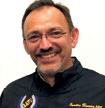 The WIDTH protocol has fascinated Wellington, Fla., farrier Curtis Burns since its inception.
The WIDTH protocol has fascinated Wellington, Fla., farrier Curtis Burns since its inception.
Cornell University’s head farrier Steve Kraus came up with the protocol to help practitioners determine the appropriate hoof care:
• Work. What does the horse do?
• Intensity. How hard does the horse regularly work?
• Duration. How many hours or miles does the horse work?
• Terrain. How hard or forgiving is the working surface? Is traction needed to be safe while being competitive?
• Horse. What is the breed, conformation, health issues and how is the horse cared for and used?
After receiving the Hall Of Fame farrier’s blessing, Burns shared his own version — LENGTH — for farriers to consider when shoeing performance horses during North Carolina State University’s Equine Health Symposium on Saturday.
• Lameness. It’s important to understand the lamenesses that horses experience and what can and can’t be done for them.
“The frustrating thing for me is there’s a lack of knowledge about what can be done for these horses,” says the inventor of Polyflex horseshoes. “I’ve seen so many horses put on the shelf for long periods of time over injuries that they didn’t really need to go through. In some cases, if you give some of these older show horses too much time off, it’s really tough bringing them back. By learning good shoeing techniques, keeping these horses going can be very beneficial for them, as much as keeping them in the ring for the client.”
• Evolution. The advances in various therapeutic techniques, as well as horseshoes and their application, have provided farriers with a number of tools with which to use.
• Negotiate. It’s critical that farriers and vets work together for the benefit of the horse.
“Farriers and vets can actually work together,” Burns says. “I have a difficult client that a vet and I work with. We make sure that we’re always in the loop and watch each other’s back.”
The most important thing that vets can do for a farrier, he says, is ask a question first.
“It automatically puts us in a position where we can start communicating,” Burns advises the attendees, who were made up of farriers, vets and students. “We have common ground where we both can try to help the horse. When we get told to do something first and then asked, we automatically go into defensive mode, where we have to defend whatever decision we’ve made. That’s not a very comfortable place to be.”
• Gaits. Learning and understanding gaited horses can lead to knowledge in other disciplines.
“The coolest thing for me is being able to be involved with so many different disciplines,” he says. “It’s amazing how many things you can carry from one to the next. You might not be able to compete in some of the same packages, but you might be able to take some things and apply it in a therapeutic aspect.”
• Trim. “The trim is, of course, everything,” Burns says.
Before beginning, he looks at the conformation of the horse and the knees.
“The plane of the knee tells me where the breakover is going to be in that foot, and medially and laterally,” he says. “One of the most important things to look at when evaluating a horse you’ve never seen is the cowlick at the back of the pastern. If you stand behind horses that are tiled way out, even though they X-ray level, a lot of times it’s lateral toe. You can make a few swipes of a lateral toe and all of a sudden, that thing will start to drop in the plane. Instead of that horse standing wide, all of a sudden it drops underneath itself.”
• Hind. Too often, the hind end is ignored or its influence on front-end injuries goes unnoticed.
“This is probably my biggest pet peeve,” Burns says. “I think it’s one of the most under appreciated things in the industry. So many times I’m brought in on cases where the horses have obvious problems up front only to find that the hinds are causing the problem. I’ll see horses standing like a duck. In 5 minutes I’ve been able to move the horses’ foot in just by balancing the foot and getting it under them with a trim.”
Among the other lectures of the day, Burns discussed how to successfully glue horseshoes; Colleen Best of Ontario Veterinary College, led an interactive lecture on communication in professional relationships; Hall Of Fame vet Dick Mansmann spoke about preventative footcare programs; and Raul Bras, another Hall Of Fame vet, examined shoeing considerations in lameness examinations of performance horses.







